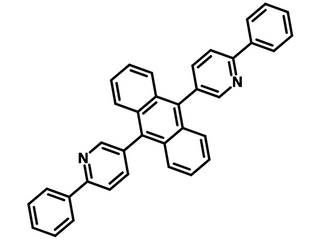DPPyA
CAS Number 1257879-34-7
Charge Transport Layer Materials, High Purity Sublimed Materials, Materials, OLED Materials, Semiconducting Molecules, TADF MaterialsLow price, high purity DPPyA
Electron transport layer material with high electron mobility, 9,10-bis(6-phenylpyridin-3-yl)anthracene, DPyPA, CAS No. 1257879-34-7, Sublimed ≥99.0%
DPPyA consists of an anthracene core joined by two electron withdrawing phenylpyridine units. With two adjacent pyridine units, it is electron deficient. As a result, DPPyA is normally used as an electron transport layer material, either on itself or together with Liq as dual electron transport layer materials in organic light-emitting diodes.
The pyridine units of DPPyA not only facilitate charge injection, but also enhance the electron-transporting mobility, benefitting from the closely packed molecules induced by the intermolecular H---N hydrogen bonding. DPPyA achieved high electron mobility of 1.5 × 10− 3 cm2/Vs under the electric field of 5.5 × 105 V/cm due to the existence of good molecular stacking.
Owing to its high electron mobility, lower operation voltages and high current densities can be observed in devices with DPPyA as electron transport layer material.
General Information
| CAS number | 1257879-34-7 |
|---|---|
| Chemical formula | C36H24N2 |
| Molecular weight | 484.59 g/mol |
| Absorption | λmax 379, 401 nm |
| Fluorescence | λem 439 nm |
| HOMO/LUMO | HOMO = 5.9 eV, LUMO = 3.0 eV [1] |
| Full name | 9,10-bis(6-phenylpyridin-3-yl)anthracene |
| Synonyms | DPyPA, DPPyA |
| Classification / Family | Anthracene derivatives, electron transport layer materials, sublimed materials, TADF materials, OLEDs, organic electronics |
Product Details
| Purity | Sublimed* >99.0% |
|---|---|
| Melting point | Tg = 135 °C, |
| Color | White Powder |
Sublimation is a technique used to obtain ultra pure-grade chemicals. For more details about sublimation, please refer to the Sublimed Materials for OLED devices page.
Chemical Structure

Device Structure(s)
| Device structure | (ITO)/HATCN (5 nm)/NPB (30 nm)/BCzPh (10 nm)/α,β-ADN:x wt% pSFIAc2 (30 nm)/CzPhPy (20 nm)/DPPyA (20 nm)/LiF (0.5 nm)/Al (150 nm) [2] |
|---|---|
| Color |
|
| Max. EQE | 9.1% |
| Max. Power Efficiency | 5.2 lm W−1 |
| Device structure | (ITO)/HATCN (4.2 nm)/NPB (30 nm)/TCTA (10 nm)/mCP (10 nm)/mCBP:20 wt% TCTPCF3:1 wt% TCz-BN1 (30 nm)/CzPhPy (10 nm)/DPPyA (30 nm)/LiF (1 nm)/Al (100 nm) [3] |
|---|---|
| Color |
|
| Max. EQE | 11.5% |
| Max. Current Efficiency | 31.1 cd/A |
| Max. Power Efficiency | 22.2 lm W−1 |
| Device structure | (ITO)/HATCN (4.2 nm)/NPB (30 nm)/TCTA (10 nm)/mCP (10 nm)/mCBP:20 wt% DACT-II:5 wt% TCz-BN2 (30 nm)/CzPhPy (10 nm)/DPPyA (30 nm)/LiF (1 nm)/Al (100 nm) [3] |
|---|---|
| Color |
|
| Max. EQE | 25.1% |
| Max. Current Efficiency | 81.1 cd/A |
| Max. Power Efficiency | 79.7 lm W−1 |
Pricing
MSDS Documentation
Literature and Reviews
- Ultrahigh-Efficiency Green PHOLEDs with a Voltage under 3 V and a Power Efficiency of Nearly 110 lm W−1 at Luminance of 10 000 cd m−2, D. Zhang et al., Adv. Mater., 29 (40); 1702847 (2017); 10.1002/adma.201702847.
- Highly efficient and stable deep-blue OLEDs based on narrowband emitters featuring an orthogonal spiro-configured indolo[3,2,1-de]acridine structure, Chem. Sci., 2022; DOI: 10.1039/D2SC01543A.
- Multi-resonant thermally activated delayed fluorescence emitters based on tetracoordinate boron-containing PAHs: color tuning based on the nature of chelates, G. Meng et al., Chem. Sci., 13, 1665 (2022); DOI: 10.1039/d1sc05692a.
| Grade | Order Code | Quantity |
|---|
